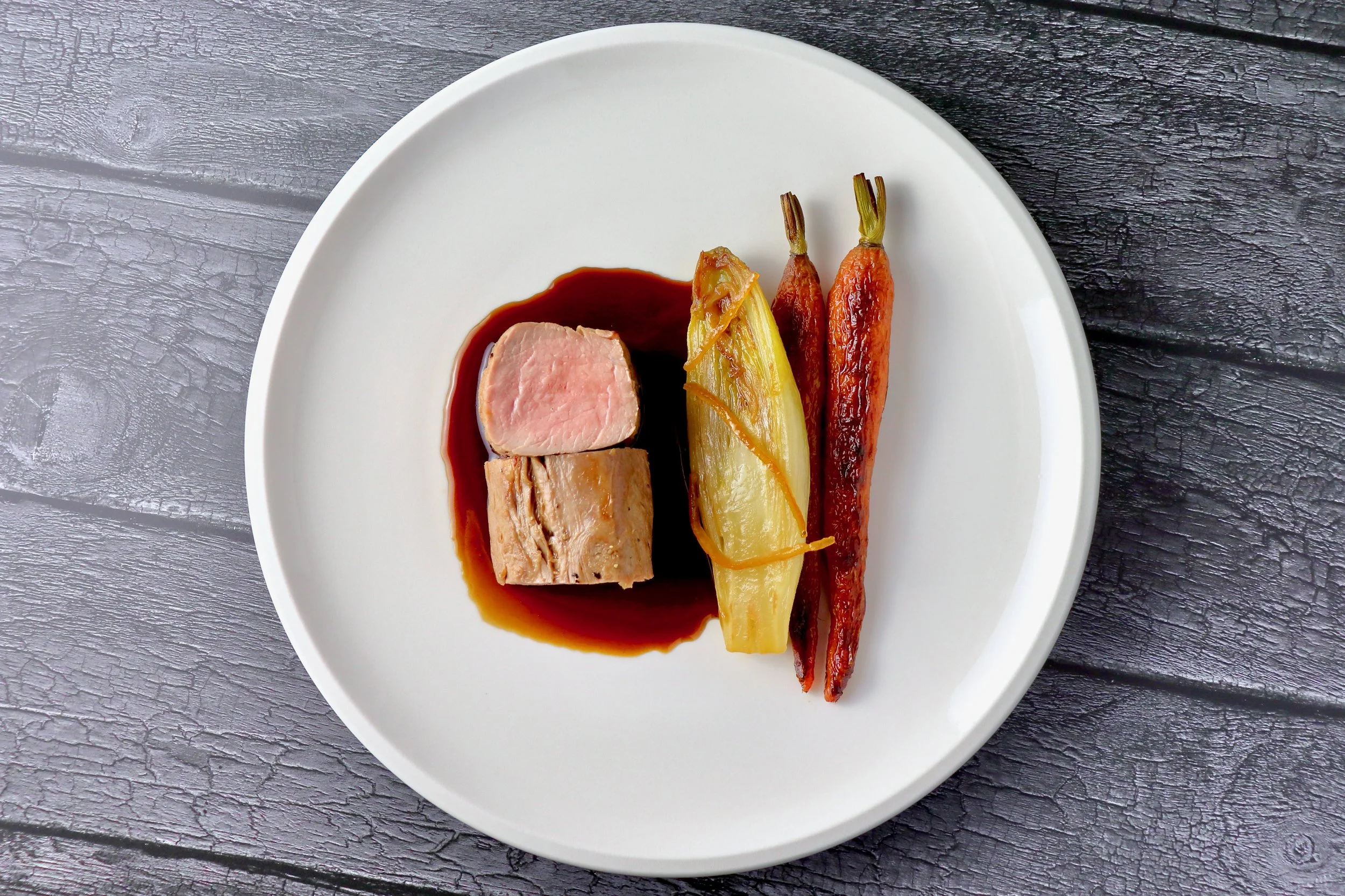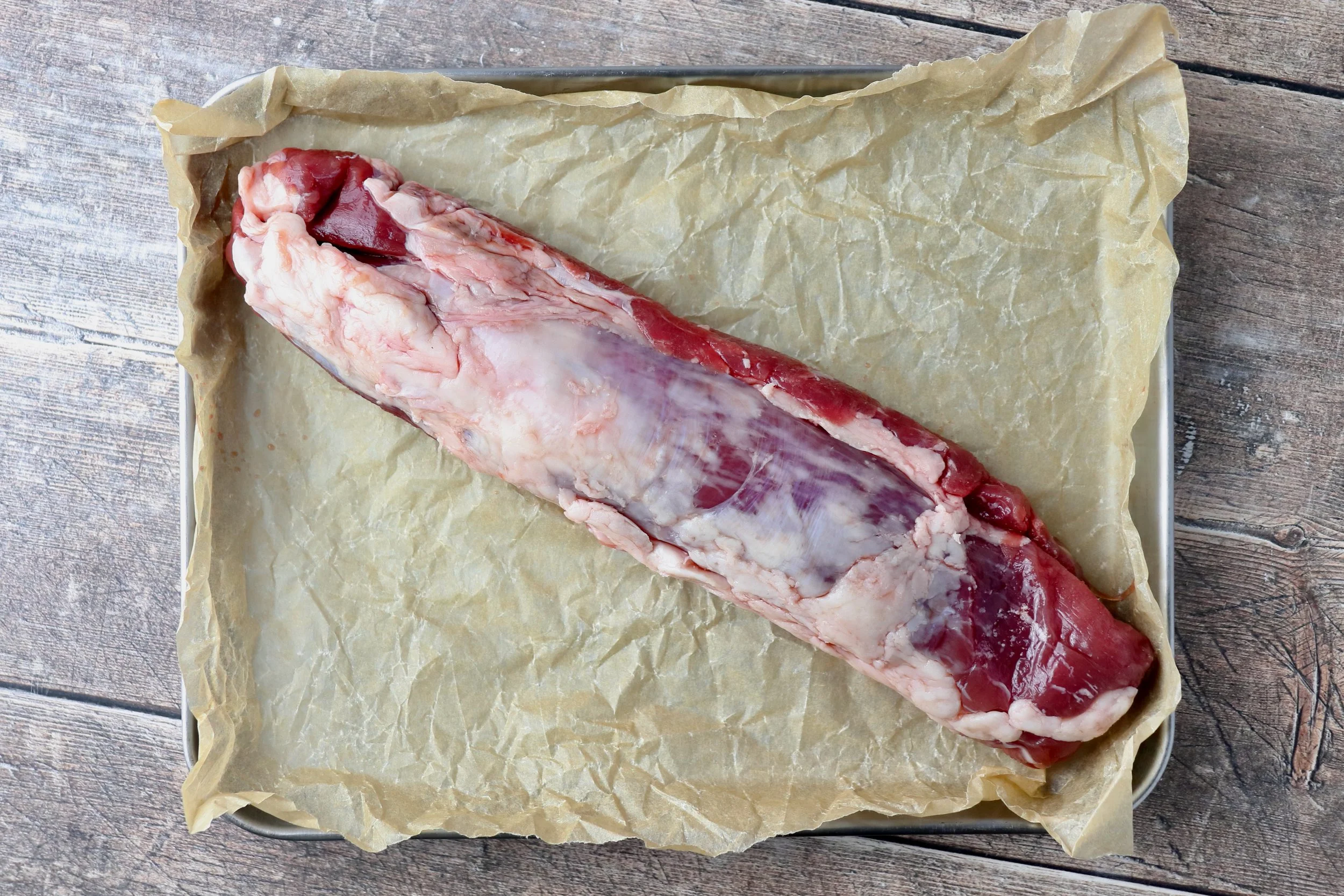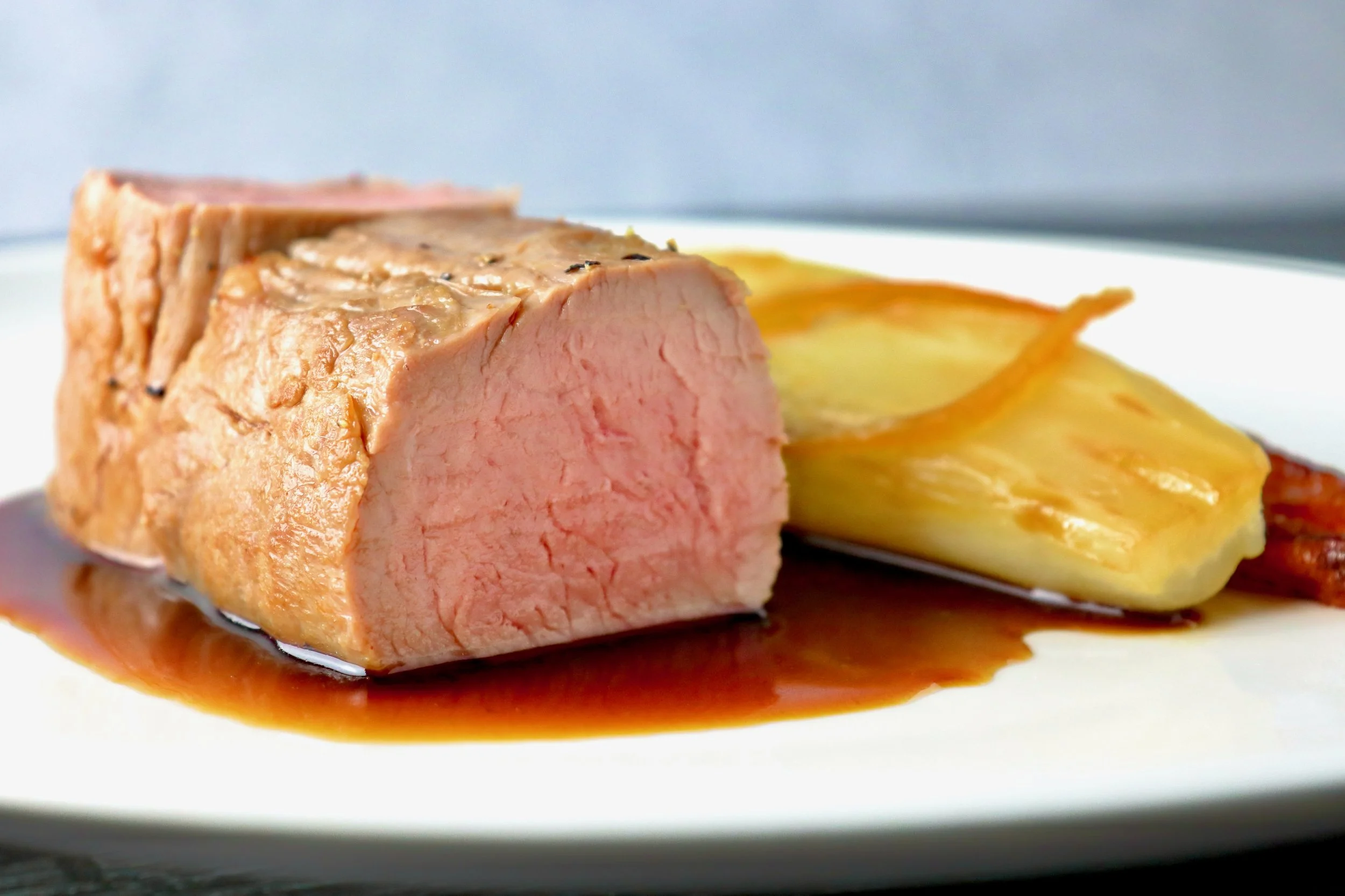Ibérico pork fillet
Ibérico pork tenderloin glazed with orange, honey and coriander. Pedro Ximénez sauce. Citrus-brasied chicory, carrots roasted in Ibérico fat, and candied orange peel
The fillet or solomillo is one of the most prized pieces of Ibérian pork. Roaming the Ibérian Peninsula, the pigs’ diet is rich with acorns producing unparalleled marbling and flavour. This is a dish of playful contrasts. The tender fillet, cooked only slightly to preserve its juiciness, against the deeply roasted, caramelised carrots. The porky Pedro Ximénez sauce, carrying aromas and sweet flavours of raisins, liquorice and dried figs cut by the citrus-sharp, bitter chicory. All accentuated by notes of orange.
Ingredients
Feeds 4
2 Ibérico pork fillets, weighing approx. 500g each
CANDIED ORANGE PEEL
2 large oranges
200g granulated sugar
200ml water
ORANGE GLAZE
80ml orange juice, freshly squeezed
1tbs honey
10g unsalted butter
0.5 tsp ground coriander
ROASTED CARROTS
8 young carrots, with the tops left on
50g pork lard; some can be rendered from the pork trimmings
30g unsalted butter
BRAISED CHICORY
2 chicory
20g unsalted butter
20ml orange juice, freshly squeezed
10ml lemon juice, freshly squeezed
PEDRO XIMÉNEZ SAUCE
4 banana shallots
10g unsalted butter
4 sprigs of thyme
200ml Pedro Ximénez sherry
400ml chicken stock, I use TRUEfoods
10g cold unsalted butter, cut into small cubes
Method
The day before, trim the pork fillets. First, carefully remove the chain. This is a strip of meat that runs the length of the fillet. It's separated from the fillet by fat and connective tissue. Get your finger into the fat and gently pull the chain away. Now, use a knife to remove any remaining sinew or excess fat. Tightly roll each fillet in cling film and tie off the ends. Reserve in the fridge to set up overnight.
Ibérico pork fillet
Ibérico pork fillet trimmed and prepared for cooking
Dice the pork fat and chain trimmings and place into a cold, heavy-bottomed frying pan (don’t use a non-stick). Slowly raise the heat to gradually render the fat then roast for 10-15 minutes in a 180C oven to caramelise. Drain the pan through a sieve and reserve the fat for tomorrow. Return the solids to the pan and place on the hob over a medium heat. Deglaze the pan with a little water. Drain again through a sieve and reserve the pan juices for the sauce.
You can also prepare the candied orange peel and orange glaze if you wish.
On the day, preheat the oven to 180C for roasting.
CANDIED ORANGE PEEL
1. Remove the peel from the oranges. Skin-side down, use a knife to separate any pith from the peel. Cut the peel into juliennes.
2. Juice the oranges and set aside. You want around 100ml.
3. Put the peel in a pan and cover with cold water. Bring to the boil and leave on a strong simmer for 15 mins. Drain and rinse well.
4. Bring the sugar and water to a boil, stirring to dissolve the sugar. Add the blanched peel, reduce the heat and gently simmer until translucent and soft, around 40 minutes.
5. Leave to cool in the syrup, then pass through a sieve reserving the syrup for another use. Arrange the peel in a single layer on baking parchment set on a baking tray. Put in the oven at the lowest setting for 30 mins to dry.
ORANGE GLAZE
1. Gently melt the butter in a pan with the coriander. Warm until you can smell the coriander toasting.
2. Add the orange juice and honey, stir, and bring to the boil. Reduce by a third.
3. Decant and set aside.
ROASTED CARROTS
1. Scrub the carrots carefully and cut the stems to 1.5cm.
2. Place a roasting tray with the pork lard over a high heat, add the carrots and cook for 2 minutes, tossing around to make sure they are coated in the fat and start to take on some colour.
3. Season the carrots and place in the oven for around 10 minutes. After 3 minutes, mix in the butter.
4. Remove from the pan and keep warm until ready to serve.
BRAISED CHICORY
1. Remove the outer leaves along with any damaged ones. Trim the root, being careful to keep it intact to hold the leaves together.
2. Cut each chicory in half lengthways.
3. Add butter to a deep frying pan over a medium-high heat. Whisk gently to keep the butter moving and prevent the solids burning. After 1-2 minutes the butter will stop bubbling and will turn a nut-brown colour.
4. Add the chicory cut-side down and reduce the heat to medium. Leave to caramelise slightly.
5. Add the orange and lemon juice. Cover the pan with a lid or foil. Place in the oven for 10-15 minutes, until the chicory is soft but still has a little bite to it. Keep warm until ready to serve. Season last minute.
IBÉRICO PORK
1. Turn the oven up to 200C.
2. Heat a heavy-bottomed frying pan (don’t use a non-stick) for 5 minutes.
3. Rub the fillets with some of the pork fat. Season well. Sear each side for 15 seconds and remove from the pan to a tray.
4. Brush the fillets with the orange glaze and return to the pan. Place the pan in the oven.
5. Every 3-4 minutes, turn the fillets to a new side, apply more glaze, and return to the oven. For medium-rare, aim for a core temperature of 55C at the centre of the thickest part. Or 60C for medium.
6. Transfer the fillets to a wire rack set over a tray. Rest for 15 minutes.
PEDRO XIMÉNEZ SAUCE
1. While the pork is resting, drain the fat from the pan in which the pork was cooked.
2. Add butter and sweat the shallots and thyme gently.
3. Deglaze the pan with the Pedro Ximénez sherry. Bring to the boil and reduce by half.
4. Add the chicken stock and any pan juices from yesterday. Reduce by half again, skimming as required, until the sauce is nice and syrupy.
5. Off the heat, add the cold butter cubes, 1 or 2 at a time, while swirling the pan until you have a glossy sauce. Do not overheat the sauce after this or the butter will split. Season to taste.
TO SERVE
1. Warm the plates.
2. Gently reheat the sauce.
3. Flash the carrots and chicory in the oven for a few minutes. Brush with the pan juices. Place 3 juliennes of candied orange peel over each chicory.
4. Top and tail the fillets then divide each centre cut into 4 medallions. Rest for 30 seconds.
5. To plate up, add 2 carrots on the right side with the chicory on their left. Arrange 2 medallions of pork, one with the cut side facing forward and the second facing up. Spoon the sauce around the medallions but not over them.
Ibérico pork fillet in a sweet and sour porky Pedro Ximénez sauce
Tender Ibérico fillet, cooked pink to preserve its juiciness




